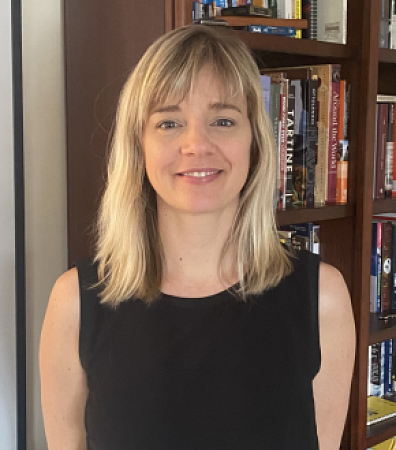
Her Groundbreaking Study of Earthquake Dynamics is Rooted in Math
Assistant Professor Brittany Erickson, a native of the San Francisco Bay Area, had her first encounter with an earthquake in 1989. She was an 8-year-old, playing outside when Loma Prieta violently shook California’s Central Coast at a magnitude of 6.9 and a maximum Modified Mercalli intensity of IX. The event was terrifying and memorable.
Fast forward to 2024 and Erickson now holds a joint position in the UO Computer Science and Earth Sciences departments, using computational mathematics and machine learning to address outstanding questions in earthquake science. Combining methods from applied math, physical modeling, and high-performance computing, she is developing new ways to model the complex dynamics of earthquake cycles and techniques; she is integrating vast amounts of data to better understand these dynamics. Her methods are built upon a new deep learning technique called the Physics-Informed Neural Network (PINN).
Why is the Physics Informed Neural Network (PINN) groundbreaking?
Like traditional artificial neural networks (ANNs), PINN is a model inspired by how neurons are organized within the brain, with the ability to send and receive signals and “learn” from experience. This learning process takes place through a complex process of mathematical operations and relies on high-performance computing to make computations tractable. PINNs differ from ANNs in the sense that they learn from observational data but are constrained to produce model results consistent with the underlying physics.
Support from the National Science Foundation.
Recognizing the far-reaching potential for future development, application, and analysis of PINN, the National Science Foundation (NSF) presented Erickson with their highly regarded CAREER award for Physics-Informed Deep Learning for Understanding Slip Complexity. This is her fourth NSF award as Principal Investigator, funding her research to “further our understanding of earthquake processes, contributing to seismic hazard estimates, and helping mitigate the associated damage to population centers, infrastructure, and the environment.” In total, Erickson has received $2M from the NSF to fund both past and present research. The award also provides for outreach to students at Lane County Community College with the Research Experience for Undergraduates (REU) program, a two-week long, paid internship for students to receive training on quantitative tools.
A process challenged by a mask of uncertainty.
Much of Erickson’s work deals with inverse problems. PINNs offer a lens into fault zone properties at depth; being able to account for what cannot be seen is the key to a better understanding of earthquakes. These are extremely important mathematical problems simply because they reveal parameters that cannot be directly observed. “What we lack is a robust uncertainty quantification. You can predict something, but you don’t really know if the output is right or wrong and really, how wrong might that be?” Erickson continues with questions, “How sensitive is this model to small changes? Can we infer properties at depth and to what degree of accuracy?”
Where does the research go from here?
To identify the conditions that enable the world’s largest earthquakes, she makes clear the need for a better understanding of frictional properties, pore fluid effects, material and geometric complexities which affect fault locking and rupture potential, all of which must be accounted for in a mathematical model capable of integrating observational data. Earthquake slip behavior is simply not well understood.” At least, not yet.
Settling down in the Pacific Northwest
Brittany and her husband, also a professor in Earth Sciences, see Eugene as a great place to raise their growing family. At the end of an intensive week spent coding and developing quantitative methods with her graduate students, Erickson says, "It's just nice to unwind with a hike in a rainforest that’s nearby.
